|
|
|
| Home > Temple Stay > Temple Stay - Gwangju |
|
 |
 |
 |
 |
 |
If you wish to have more information of Korean Templestay,
please send us
e-mail or fax (+82-2-6092-8150).
|
 |
 |
|
|
 Song-kwang sa Song-kwang sa |
 |
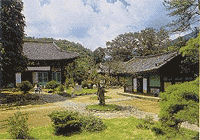 Song-kwang sa is one of the three jewel monasteries (Buddha, Dharma, Sangha) with Tongdosa and Haeinsa. It is the Sangha jewel monastery because it has produced 16 national teachers, a large number of highly learned Buddhist monks and men of high moral character. The portraits of the 16 national teachers are still enshrined in the Hall of Teachers (Guksajeon, National treasure No.56) at Songkwangsa. Buddhist monks from various countries are learning about Korean Buddhism at the Bulil International Buddhist center, opened in 1972. It is a Buddhist seminary, representative of Korean schools, to teach the practicing of meditation and the sutras. There are many wooden buildings standing in a row in Song-kwang sa. The main hall is in the center and the others are around it, such as Sulbubjeon, Suseonsa, Sangshadang, Hasadang (Treasure No.263), Eungjinjeon, Guksajeon (Treasure No.56), Jinyounggak, Yakshajeon (Treasure No.302) and Youngsanjeon (Treasure No.303). This temple owns various Buddhist cultural properties that are national treasures, including Mokjo-samjohn-bulgam (carved wooden case for three noble Buddhas). Song-kwang sa is one of the three jewel monasteries (Buddha, Dharma, Sangha) with Tongdosa and Haeinsa. It is the Sangha jewel monastery because it has produced 16 national teachers, a large number of highly learned Buddhist monks and men of high moral character. The portraits of the 16 national teachers are still enshrined in the Hall of Teachers (Guksajeon, National treasure No.56) at Songkwangsa. Buddhist monks from various countries are learning about Korean Buddhism at the Bulil International Buddhist center, opened in 1972. It is a Buddhist seminary, representative of Korean schools, to teach the practicing of meditation and the sutras. There are many wooden buildings standing in a row in Song-kwang sa. The main hall is in the center and the others are around it, such as Sulbubjeon, Suseonsa, Sangshadang, Hasadang (Treasure No.263), Eungjinjeon, Guksajeon (Treasure No.56), Jinyounggak, Yakshajeon (Treasure No.302) and Youngsanjeon (Treasure No.303). This temple owns various Buddhist cultural properties that are national treasures, including Mokjo-samjohn-bulgam (carved wooden case for three noble Buddhas). |
|
 |
 |
 |
|
|
 Hwa-eom sa Hwa-eom sa |
 |
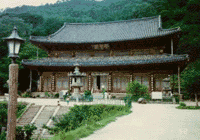 Hwa-eom sa is located at the foot of JiRi Mountain, a spiritually important Korean mountain which is covered with luxuriant woodlands, clouds, and mist.Hwa-eom sa is believed to have been named after the Avatamsaka Sutra, which is "hwa-eum in Korean. The first temple was founded on this site in the year 544 CE (the 22nd year of the reign of King Seong of Baekje Kingdom).There are many cultural assets at Hwa-em sa, such as the largest temple building in the country, the largest stone lantern in the world, and a unique, 3-story stone stupa, whose four supporting pillars are carved lions. Hwa-eom sa is located at the foot of JiRi Mountain, a spiritually important Korean mountain which is covered with luxuriant woodlands, clouds, and mist.Hwa-eom sa is believed to have been named after the Avatamsaka Sutra, which is "hwa-eum in Korean. The first temple was founded on this site in the year 544 CE (the 22nd year of the reign of King Seong of Baekje Kingdom).There are many cultural assets at Hwa-em sa, such as the largest temple building in the country, the largest stone lantern in the world, and a unique, 3-story stone stupa, whose four supporting pillars are carved lions. |
|
 |
 |
 |
 Baik-yang sa Baik-yang sa |
 |
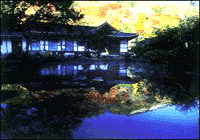 Baik-yang sa was built in the Baikje Dynasty and called Baik-am sa or Jung-to sa at first. There is a legend behind the name Baik-yang sa. In the Yi Dynasty, the great monk Whanyang Sunim held a Dharma Assembly at this temple. In the middle of the congregation, a white sheep was listening his Dharma talk. On the last day of the Dharma Assembly, the white sheep appeared in the dream of Whanyang Sunim and said that the sheep wanted to thank to him for rebirth as a human because of his Dharma talk. The next day, monks found the dead body of the white sheep in front of the cave below the temple. So, monks cremated the dead sheep and renamed the temple Baik-yang sa, which means white sheep temple. The oldest building of this temple compound is the Hall of Amitabha, and a Buddha statue made of paper is enshrined in this hall. Baik-yang sa was built in the Baikje Dynasty and called Baik-am sa or Jung-to sa at first. There is a legend behind the name Baik-yang sa. In the Yi Dynasty, the great monk Whanyang Sunim held a Dharma Assembly at this temple. In the middle of the congregation, a white sheep was listening his Dharma talk. On the last day of the Dharma Assembly, the white sheep appeared in the dream of Whanyang Sunim and said that the sheep wanted to thank to him for rebirth as a human because of his Dharma talk. The next day, monks found the dead body of the white sheep in front of the cave below the temple. So, monks cremated the dead sheep and renamed the temple Baik-yang sa, which means white sheep temple. The oldest building of this temple compound is the Hall of Amitabha, and a Buddha statue made of paper is enshrined in this hall. |
|
 |
 |
 |
 |
 |
 Dae-dun sa Dae-dun sa |
 |
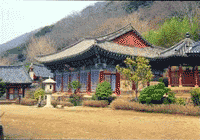 Susan Daesa(a great Buddhist monk) was a famous Seon(zen) monk of Chosun Dynasty and also a patriotic monk who fought against invasion of Japan. It was the year of dragon when Japan invaded and ravaged the Korean peninsular. Susan Daesa organized the monk armies to protect the nation from Japan. He claimed Daedunsa is the ideal spot for keeping peace from foreigner's invasion. In addition, he made Daedunsa the centre of Korean Seon Buddhism. Daedunsa is keeping the alms bowl and the ceremonial cloak of Susan Daesa. Also, this temple has many cultural properties and traces of artists of the late Yi Dynasty. In eighteen century of Yi Dynasty, Choeu Sunim(a Buddhism monk) lived at Daedunsa. He established the tea ceremony as an organized thoughts. When you pass the enterance of the temple compound, you meet the 4 km tunnel of pine trees, camelia trees, fir trees, cherry trees, and Gorosae trees (a Korean syrup tree). You will be surprised at the diversity of greens in summer and shades in autumn. Susan Daesa(a great Buddhist monk) was a famous Seon(zen) monk of Chosun Dynasty and also a patriotic monk who fought against invasion of Japan. It was the year of dragon when Japan invaded and ravaged the Korean peninsular. Susan Daesa organized the monk armies to protect the nation from Japan. He claimed Daedunsa is the ideal spot for keeping peace from foreigner's invasion. In addition, he made Daedunsa the centre of Korean Seon Buddhism. Daedunsa is keeping the alms bowl and the ceremonial cloak of Susan Daesa. Also, this temple has many cultural properties and traces of artists of the late Yi Dynasty. In eighteen century of Yi Dynasty, Choeu Sunim(a Buddhism monk) lived at Daedunsa. He established the tea ceremony as an organized thoughts. When you pass the enterance of the temple compound, you meet the 4 km tunnel of pine trees, camelia trees, fir trees, cherry trees, and Gorosae trees (a Korean syrup tree). You will be surprised at the diversity of greens in summer and shades in autumn. |
|
 |
 |
 |
|
|
 Mi-whang sa Mi-whang sa |
 |
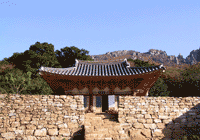 The Buddhist temple Mi-whang sa is located near the Namhae Sea and the sunset there is a very beautiful scene. Mi-whang sa has many stupas which were built by Buddhist monks, for the relics of passed monks. On these stupas, many interesting figures are carved, such as a duck, fish, an octopus, a rabbit, a dragon, a lotus, the face of ghost, and others. One thousand Buddha figures are painted on the ceiling of the Main Buddha Hall, which is National Cultural Treasure No. 947. The Main Buddha Hall is very old, and has the beauty of simplicity. The Buddhist temple Mi-whang sa is located near the Namhae Sea and the sunset there is a very beautiful scene. Mi-whang sa has many stupas which were built by Buddhist monks, for the relics of passed monks. On these stupas, many interesting figures are carved, such as a duck, fish, an octopus, a rabbit, a dragon, a lotus, the face of ghost, and others. One thousand Buddha figures are painted on the ceiling of the Main Buddha Hall, which is National Cultural Treasure No. 947. The Main Buddha Hall is very old, and has the beauty of simplicity. |
|
 |
 |
 |
|
|
 Jueng-shin sa Jueng-shin sa |
 |
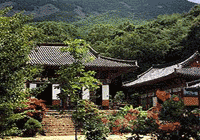 Seon Master Chulkam (798~868) first built Jeung-shim sa in the era of the Unified Shilla Kingdom, but several wars destroyed it. Therefore, it has lost its original state through four rebuilding processes. However, Obaekjeon, built in 1609 or thereabouts, is a hall in its original form since then, and it enshrines the statues of Sakyamuni Buddha, His 16 disciples and 500 arahants. In addition, Jeung-shim sa possesses an iron statue of Vairocana Buddha, a three-storied stone pagoda bequeathed from the era of the Unified Shilla Kingdom, and a standing statue of Bodhisattva handed down from the Koryo period. Seon Master Chulkam (798~868) first built Jeung-shim sa in the era of the Unified Shilla Kingdom, but several wars destroyed it. Therefore, it has lost its original state through four rebuilding processes. However, Obaekjeon, built in 1609 or thereabouts, is a hall in its original form since then, and it enshrines the statues of Sakyamuni Buddha, His 16 disciples and 500 arahants. In addition, Jeung-shim sa possesses an iron statue of Vairocana Buddha, a three-storied stone pagoda bequeathed from the era of the Unified Shilla Kingdom, and a standing statue of Bodhisattva handed down from the Koryo period. |
|
 |
 |
 |
|
|
 Mugak sa Mugak sa |
 |
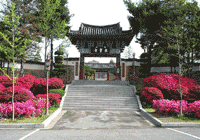 Mugaksa in Gwang-ju was built to serve the military as a Buddhist center in 1971. Mugaksa is located in the 'May 18th Citizen's Park' in the City of Gwang-ju. The size of the Dharma Hall is 110 Pyong (1 Pyong = 3.95 square yards); it is the largest one in South Jul-la province. Also, there are: the largest bell in Gwang-ju area, the bell pavillion, and a 13-story stone stupa. Mugaksa in Gwang-ju was built to serve the military as a Buddhist center in 1971. Mugaksa is located in the 'May 18th Citizen's Park' in the City of Gwang-ju. The size of the Dharma Hall is 110 Pyong (1 Pyong = 3.95 square yards); it is the largest one in South Jul-la province. Also, there are: the largest bell in Gwang-ju area, the bell pavillion, and a 13-story stone stupa. |
|
 |
 |
 |
 |
 |
If you wish to have more information of Korean Templestay,
please send us
e-mail or fax (+82-2-6092-8150).
|
 |
 |
 |
|
|
|
|
|